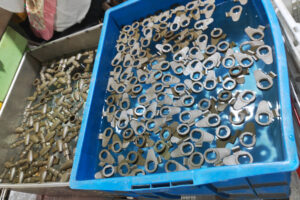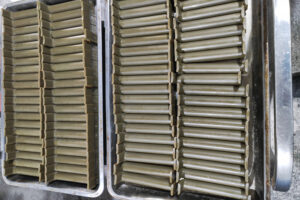Mold material

Wax-based mold material
Wax-based mold material is actually paraffin stearic acid mold material, and the commonly used formula is 50% paraffin wax and 50% stearic acid. The ingredient requirements are that the paraffin wax (CnH2n+2) should be a refined or semi-refined white paraffin wax with a melting point of ≥58℃. The stearic acid (C17H35 COOH) should be a first-grade (three-pressure) stearic acid (block).
Paraffin is the basic component of mold material. The addition of stearic acid is due to the polarity of stearic acid molecules, which has good wettability for coatings, improves the coating properties of mold material, and is beneficial to the improvement of thermal stability of material. Liquid paraffin and stearic acid have good compatibility. This kind of material has low melting point, easy preparation, easy mold making and dewaxing, high wax recovery rate, and good reusability. If the ratio of paraffin and stearic acid is changed, it will affect the properties of mold materials. When the content of paraffin is increased by 10%, the strength of mold material can be increased. When the content of paraffin is increased beyond 80%, the surface of mold material is prone to foaming, the surface quality of mold is poor, and the coating properties and fluidity of mold material decrease. If the content of stearic acid is increased by 10%, the coating properties, fluidity and thermal stability of mold materials will be improved. When the content of stearic acid exceeds 80%, the strength of material is very low and the toughness is also very poor, so it cannot be used
The strength and thermal stability of paraffin stearic acid mold materials are not high (softening point is 31℃), and in the process of use, stearic acid is prone to undergo displacement reaction with active metals, and also prone to neutralization reaction with alkali or alkaline oxide, resulting in the formation of water-insoluble saponification (stearate), which deteriorates the mold materials, and the viscous saponification residue on the cavity surface will affect the surface quality of the casting. Since the saponification reaction consumes some stearic acid in the mold materials, adding new stearic acid during mold material recycling is beneficial to stabilizing the performance of the mold materials.
The performance of paraffin stearic acid mold material is not only related to the ratio of mold material, but also affected by the melting point of paraffin. If using 60℃
Using high-grade paraffin wax instead of 58°C paraffin wax can significantly improve the strength and thermal stability of the mold material, as well as reduce the shrinkage rate, thereby improving the performance of the mold material
Although the paraffin stearic acid mold material has the advantages of convenient preparation, easy mold release, and good reusability, it also has the disadvantages of low thermal stability and easy deformation, especially during production. This mold material must be reused after treatment to prevent saponification and deterioration. The residual acid liquid during the reusing process is prone to polluting the environment, so in recent years, various wax-based mold materials without stearic acid have been introduced
Low molecular weight polyethylene wax mold material

The composition of the low molecular weight polyethylene mold material for paraffin wax is 95% paraffin wax and 5% low molecular weight polyethylene. The melting point of this mold material is 66℃, and the softening point is about 34℃. The molecular weight of low molecular weight polyethylene is about 2000~5000, and it has good compatibility with paraffin wax. Using low molecular weight polyethylene instead of stearic acid to prepare wax-based mold materials has the advantages of high strength, good toughness, smooth surface of the mold, stable chemical properties, no saponification after use, and convenient mold recovery. This mold material has a high viscosity, so it is necessary to appropriately increase the temperature and wax injection pressure of the paste mold materials during molding
In the wax-based non-stearic acid mold materials, polyethylene, EVA, lignite wax, paraffin, rosin and other materials are added. The low-density polyethylene has a low solubility in paraffin, generally not exceeding 10%. However, the smaller the molecular weight of polyethylene, the greater its solubility in paraffin. Therefore, low molecular weight polyethylene and EVA with molecular weights of 2000-5000 are more soluble than low-density polyethylene. Moreover, the molecular structure of polyethylene is similar to that of paraffin, which can play a role as a crystallization core in wax-based mold materials, refining the crystals of paraffin and improving the mechanical properties of mold materials. Therefore, adding low molecular weight polyethylene to wax-based mold materials can improve the strength and heat resistance of mold materials. However, if the addition amount is too large, the performance improvement will not be significant, but the shrinkage rate will increase. Adding EVA also has a similar effect. Production and application practices have shown that long-term use of polyethylene will exhibit aging characteristics and deteriorate mold materials properties. Adding lignite wax can improve the thermal stability of mold materials, but at the same time, the melting point and injection temperature of mold materials will also increase
In polymers such as polyethylene, in addition to crystalline structures, there is also an amorphous (amorphous) structure, which means that it has a special structure where two phases coexist simultaneously, namely crystalline regions and amorphous regions (amorphous regions). In the crystalline regions of polyethylene spherulites, there are polymer chains connecting between the crystal plates, and each polymer can penetrate several crystal regions and amorphous regions. Due to the existence of such linking chains, the strength of polyethylene is much higher than that of waxy materials
In addition to polyethylene and ethylene-vinyl acetate copolymer resin (EVA), polystyrene can also be added to wax materials. Polystyrene has a high melting point, is insensitive to temperature changes, has a lower thermal deformation than wax materials, has high strength and hardness, and has a low shrinkage rate. It has high transparency and can be added to mold materials to increase strength and softening temperature, but it is not widely used due to its high viscosity and poor release properties
Resin-based mold materials
The matrix of resin-based mold material (commonly known as medium-temperature wax) is resin, which is divided into natural resin and synthetic resin. The advantages of resin-based mold material are high strength, high thermal stability, and low shrinkage rate. It is mainly used for the production of high-quality investment casting products. The raw materials of resin-based material are: rosin, polymerized rosin, rosin ester, and maleic anhydride rosin ester.
In order to meet the requirements of precise and complex investment casting for mold material quality and performance, a series of commercial mold materials (also known as resin-based mold materials) have been developed at home and abroad. Professional mold material factories develop and produce a series of mold materials with stable performance, such as the CL163 series mold materials (produced by ACCU-END Co., USA), MASTER series (produced by Kindtcollins Co., USA), CA-STYLEND series (produced by Yates Co., UK), BLASON OLEFINES series, and K-512 series mold materials in Japan. Commercial series mold materials can be divided into molding wax, runner wax, bonding wax, repair wax, dip sealing wax, water-soluble wax, sample wax, etc. according to their uses and characteristics
Filler mold materials
Packing mold material, also known as filling mold materials, is formed by adding a filling material to the mold materials. Both solids, liquids, and gases can be used as filling materials. The main function of adding a filler to the mold material is to reduce shrinkage, prevent deformation and surface recession of the investment casting surface, and improve the surface quality and dimensional accuracy of the investment casting.
In practical production, the most commonly used mold materials are solid powder fillers, mainly including polyethylene, polystyrene, polyvinyl alcohol, polyvinyl chloride, synthetic resin, polyethylene glycol, rubber, urea powder, carbon black, etc. Usually, wax-based and resin-based mold materials cannot be solid solutions composed of raw materials after melting. The characteristic of solid fillers is that they will not melt at working temperature and become evenly dispersed solid particles in the mold materials. They can absorb the potential energy released by the mold material during solidification and act as aggregates, thus improving the cooling effect of the mold materials, reducing shrinkage, increasing thermal stability and strength of the mold material, preventing deformation and surface depression of wax molds. In addition, it can significantly improve the wax injection process performance of liquid mold materials. The addition amount of solid fillers is 10%-40%
Requirements for fillers: high melting point, will not melt at the working temperature of the mold material, has good affinity for liquid mold material, is easy to wet, but will not undergo chemical reactions, the filler particle size is appropriate, the density is moderate, and there is less residual ash after calcination. Most of the liquid filler mold materials use water as the filler to prepare water lotion filler mold materials
Example of preparation process of water lotion filler pattern material: the pattern material consists of 30% lignite wax, 26% lignite wax resin, 20% paraffin wax and 24% water. First, heat and melt the solid mold material, then add a small amount of liquid emulsifier and stir evenly. Then, add 90 ℃ hot water for high-speed stirring to produce a wax water emulsion, which becomes the liquid filler mold material. The solution mold is made by using water emulsifier filling material and a high-pressure wax injection mechanism, with a smooth surface, low surface roughness, and no depression. It is mainly used for producing investment molds with high dimensional accuracy requirements







